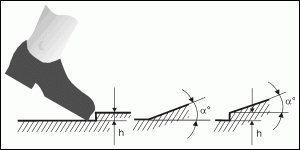The human walk is one of the most insecure types of movement
One step, as simple as it may seem, is the result of a complex and coordinated movement of the individual parts of the musculoskeletal system.
One step is facilitated through movements of the ankle, the knee, and the hip, as well as through the stabilising movement of torso and upper body, first and foremost through com-pensating movements of the arms.
The step movement may be divided into individual phases. It is initially initiated from the support phase through a suspended movement of one of the legs in a forwards direction. Within the framework of the roll-over movement of the supporting foot in a forwards direction, a repulsive force is exerted in a rear direction. Then, the suspended foot makes contact to the ground via its heel. This ends the roll-over movement of the support foot. Now, the suspended foot becomes the support foot, the roll-over movement of which starts thereafter. In this transitory phase, both feet are in a support phase for about 0.1 seconds.
The duration of this joint support phase may vary. In general, the following applies: the faster the step speed, the shorter this support phase will become.
The acceleration and braking forces exerted on the centre of gravity are transferred to the ground via the respective support leg in a roll-over movement of the foot.
The position of the centre of gravity changes constantly - both within the body and in the movement area. In order to hold the balance, the extremities (for example, the arms) and other parts of the body are used to perform compensation movements. Together with the step movement, these compensation movements result in a complex movement.
Stumbling
A human being starts to stumble when the following happens: After the roll-over movement at the beginning of the floating phase or while swinging through the rear foot, the forward section of the foot - or in some cases the heel - is blocked by an obstacle.
If the forces induced by blocking the movement cannot be compensated by the support foot, the balance may be disturbed.
Stumbling can be divided into three groups:
1. Getting caught with the toecap on ridges, such as steps, inclines, arches, that are formed above the normal surface level of the stepping area.

2. Getting caught with the toecap on recesses, such as grooves, cracks, openings, below the surface level of the stepping area the toecap fits into, mostly in an inclined position.

3. Getting caught with the toecap on mantraps, such as supply lines, loosened edges of the surface, stair undercuts under which the foot may be inserted.

Slipping
The critical phase for slipping is the point when the foot makes contact with the surface via the heel. The following image illustrates the relative strength when making contact via the foot.
If the forces exerted on the ground by the foot (FX, Z) cannot be transferred to the ground by a sufficient fiction coefficient µ, slipping may occur. This happens if the friction coefficient µ is lower than the requirements coefficient Q.
